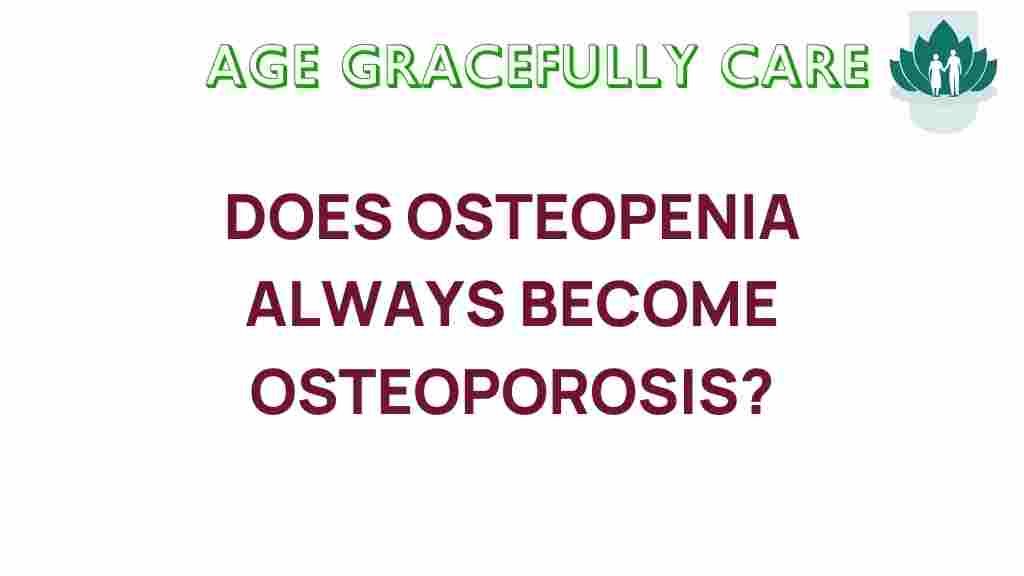Unraveling the Mystery: Does Osteopenia Always Lead to Osteoporosis?
Bone health is a critical aspect of overall well-being, especially as we age. Among the various conditions that affect our bones, osteopenia and osteoporosis are two of the most discussed. While the terms are often used interchangeably, they refer to different stages of bone density loss. This article delves into the relationship between osteopenia and osteoporosis, exploring whether osteopenia always leads to osteoporosis. We will examine risk factors, diagnosis, treatment, and prevention strategies to maintain bone health.
Understanding Osteopenia and Osteoporosis
Osteopenia is characterized by lower than normal bone density, while osteoporosis is a more severe condition where bones become brittle and fragile, increasing the risk of fractures. Understanding the distinction between these two conditions is crucial for effective management and prevention.
What is Osteopenia?
Osteopenia is often considered a precursor to osteoporosis. It is diagnosed when bone mineral density (BMD) is lower than normal but not low enough to qualify as osteoporosis. The World Health Organization (WHO) defines osteopenia using T-scores from a bone density test:
- A T-score between -1.0 and -2.5 indicates osteopenia.
- A T-score of -2.5 or lower indicates osteoporosis.
What is Osteoporosis?
Osteoporosis is a more advanced stage of bone density loss. It results in increased fragility and a higher risk of fractures, especially in the hip, spine, and wrist. Osteoporosis does not have any symptoms in its early stages, which makes it particularly dangerous, as many individuals may not realize they have it until a fracture occurs.
The Connection Between Osteopenia and Osteoporosis
Many people wonder if having osteopenia guarantees a future diagnosis of osteoporosis. The answer is nuanced. While individuals with osteopenia are at an increased risk for developing osteoporosis, not everyone with osteopenia will progress to this more severe condition.
Risk Factors for Progression
Several risk factors can influence whether someone with osteopenia will develop osteoporosis:
- Aging: Bone density naturally decreases with age, making older adults more susceptible.
- Gender: Women, especially post-menopausal women, are at a higher risk due to hormonal changes.
- Family History: Genetics can play a significant role in bone density health.
- Body Frame Size: Individuals with smaller body frames tend to have a higher risk.
- Lifestyle Factors: Poor diet, lack of exercise, smoking, and excessive alcohol consumption can all contribute.
Diagnosis of Osteopenia and Osteoporosis
Diagnosis typically involves a bone density test, which measures the amount of bone present in the hip and spine. The test is painless and non-invasive, and results are usually available within a day or two. It is recommended for:
- Women aged 65 and older.
- Men aged 70 and older.
- Individuals with risk factors for low bone density.
- Those who have broken a bone after age 50.
Treatment Options for Osteopenia and Osteoporosis
Treatment varies depending on the severity of the condition and individual risk factors. For those diagnosed with osteopenia, the focus is often on lifestyle changes and preventative measures:
1. Lifestyle Changes
Implementing healthy lifestyle changes can help maintain bone density:
- Nutrition: A diet rich in calcium and vitamin D is crucial. Aim for foods like:
- Dairy products (milk, cheese, yogurt)
- Leafy green vegetables (kale, broccoli)
- Fish (salmon, sardines)
- Fortified foods (cereals, juices)
- Exercise: Weight-bearing exercises help strengthen bones. Activities include:
- Walking
- Running
- Dancing
- Resistance training
- Avoiding Smoking and Excessive Alcohol: Both can contribute to bone loss.
2. Medications
In some cases, especially for those with osteoporosis, medication may be necessary. Options include:
- Bisphosphonates: These medications help prevent bone loss.
- Hormone Replacement Therapy: Particularly for post-menopausal women.
- Calcitonin: A hormone that can help regulate calcium levels and bone metabolism.
Prevention Strategies for Maintaining Bone Health
Preventing the onset of osteopenia and osteoporosis involves proactive measures:
- Regular Check-ups: Routine bone density screenings can help catch issues early.
- Balanced Diet: Ensure adequate calcium and vitamin D intake.
- Physical Activity: Incorporate both weight-bearing and muscle-strengthening exercises.
- Limit Risk Factors: Maintain a healthy weight, avoid smoking, and limit alcohol consumption.
Conclusion
In summary, while osteopenia can increase the risk of developing osteoporosis, it does not always lead to it. Understanding the relationship between these two conditions is vital for prevention and management. By focusing on bone health through proper nutrition, regular exercise, and lifestyle changes, individuals can reduce their risk of progression from osteopenia to osteoporosis. Early diagnosis and intervention are key to maintaining strong bones well into old age.
For more detailed information on osteoporosis and related conditions, you may find this external resource helpful. Additionally, to learn more about maintaining bone health, visit our internal guide.
This article is in the category Health and created by AgeGracefullyCare Team
